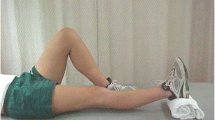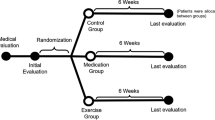Abstract
Objective
To observe the effect of complex reinforcing-reducing manipulations of acupuncture on flexion and extension angles of hip and knee in patients after surgical treatment of gluteus maximus contracture.
Methods
A total of 66 cases following surgery of gluteus maximus contracture were randomly allocated into an observation group and a control group by the random digits table, 33 in each group. In addition to basic treatment, cases in the observation group were treated with reducing manipulation [Tou Tian Liang (Heaven-penetrating Cooling)] on Zhibian (BL 54), Huantiao (GB 30) and Juliao (GB 29) on the affected side and reinforcing manipulation [Shao Shan Huo (Mountain-burning Fire)] on Biguan (ST 31), Futu (ST 32), Zusanli (ST 36), Fenglong (ST 40), Xuehai (SP 10), Diji (SP 8) and Yanglingquan (GB 34). Patients in the control group only received the same basic treatment as the observation group. The treatment was done once a day, 30 d for a course and a 1-week interval between two courses. Then the flexion and extension angles of hip and knee were evaluated using the Lokomat full automatic robot gait evaluation system after 3 courses of treatment.
Results
There were intra-group statistical differences in hip flexion angle on foot followed (HFA-FF), the maximum of hip flexion angle (MAX-HFA), the maximum of hip extension angle (MAX-HEA), knee flexion angle on foot followed (KFA-FF), the maximum of knee flexion angle on stance phase (MAX-KFA-TP) and the maximum of knee flexion angle on swing phase (MAX-KFA-WP) in the observation group and in HFA-FF, MAX-HEA and KFA-FF in the control group (P<0.05). There were between-group statistical differences in HFA-FF, MAX-HFA, MAX-HEA, KFA-FF and MAX-KFA-TP (P<0.05).
Conclusion
The complex reinforcing-reducing manipulations of acupuncture can effectively improve the hip/knee functions following surgery of gluteus maximus contracture.
摘要
目的
观察复式针刺补泻对臀大肌挛缩术后患者运动步态髋、 膝关节屈伸角度的影响。
方法
将66例臀大肌挛缩术后患者按随机数字表分为两组, 每组33例。 观察组在康复治疗基础上, 予针刺患侧秩边、 环跳、 居髎, 行透天凉泻法; 患侧髀关、 伏兔、 足三里、 丰隆、 血海、 地机、 阳陵泉, 行烧山火补法。 对照组仅予与观察组相同的基础康复治疗。 每日治疗1次, 30天为1个疗程, 连续治疗3个疗程, 疗程间休息1星期。 使用Lokomat全自动机器人步态评定系统对患者进行运动步态髋、 膝关节的屈伸角度测定。
结果
观察组患者髋关节屈曲角度值(HFA-FF)、 髋关节屈曲角度最大值(MAX-HFA)、 髋关节伸展角度最大值(MAX-HEA)、 膝关节屈曲角度值(KFA-FF)、 支撑相膝关节屈曲角度最大值(MAX-KFA-TP)、 摆动相膝关节屈曲角度最大值(MAX-KFA-WP), 及对照组患者髋关节屈曲角度值(HFA-FF)、 髋关节伸展角度最大值(MAX-HEA)和膝关节屈曲角度值(KFA-FF)与治疗前均有统计学差异(P<0.05)。 观察组髋关节屈曲角度值(HFA-FF)、 髋关节屈曲角度最大值(MAX-HFA)、 髋关节伸展角度最大值(MAX-HEA)、 膝关节屈曲角度值(KFA-FF)及支撑相膝关节屈曲角度最大值(MAX-KFA-TP)与对照组差异有统计学意义(P<0.05)。
结论
复式针刺补泻可提高臀大肌挛缩术后髋、 膝关节功能, 改善步态运动。
Similar content being viewed by others
References
Ma LQ. Surgical treatment for injection-induced gluteus maximus contracture. Harbin Yiyao, 2005, 25(6): 114–115.
Cheng ZS, Li H. Surgery treatment for gluteal muscle and fascia contracture in adults. J Pract Orthop, 2008, 14(7): 439–440.
Ping GX, Huang JK, Qiu DZ, Chen L, Yu HL, Yan JC, Tan YG, Peng W, Li RC. Diagnosis and surgical treatment of severe gluteus maximus contracture. Chin J Orthop, 2003, 23(7): 418–422.
Chen SJ, Li H. Multifactor analysis on the curative effect of acupuncture in patients with cerebral infarction. Chin J Clin Rehabil, 2005, 9(41): 4–5.
Shi XM. Xingnao Kaiqiao Acupuncture therapy for stroke. Chin J Clin Rehabil, 2003, 7(7): 1057–1058.
Ma CX, Fang LG, Liu GL. Injection-induced gluteus maximus contracture. Zhonghua Waike Zazhi, 1987, 16(6): 987–990.
Huang YT, Li JW, Lei W. Etiology, category and treatment of gluteal muscle contracture. Zhonghua Guke Zazhi, 1999, 19(2): 105–108.
Yu H, Zhang CY, Tian LS, Fang J. Exercise training for patients after surgery of gluteus maximus contracture. Xiandai Kangfu, 2010, 5(9): 139.
Guo SM, Li JM, Wu QW, Shen HT. Clinical application of Lokomat automatic robot gait training and assessment system. Zhongguo Yiliao Shebei, 2011, 26(3): 94–96.
Xu GQ, Huang DF, Lan Y, Mao YR, Liu P. Three-dimensional kinematic effect of joint movements of lower extremity on walking ability in patients with stroke. Chin J Clin Rehabil, 2004, 8(31): 6816–6818.
Ni B, Li M. The effect of children’s gluteal muscle contracture on skeleton development. Sichuan Daxue Xuebao: Yixue Ban, 2007, 38(4): 657–659.
Qiu JW. Needling techniques of setting fire on the mountain and coolness through penetrating heaven for 24 patients with Bi-impediment syndrome. Guangxi Zhongyiyao, 2000, 23(6): 33.
Wang H. Clinical observation on needling techniques of setting fire on the mountain and coolness through penetrating heaven for 30 cases with cerebral infarction. Zhongguo Zhen Jiu, 1996, 16(6): 13–14.
Yu Y. Talk on acupuncture reinforcing and reducing manipulation. Zhongyiyao Xuekan, 2006, 24(4): 748.
Prestes J, Shiguemoto G, Botero JP, Frollini A, Dias R, Leite R, Pereira G, Magosso R, Baldissera V, Cavaglieri C, Perez S. Effects of resistance training on resistin, leptin, cytokines, and muscle force in elderly post-menopausal women. J Sports Sci, 2009, 27(14): 1607–1615.
Dieli-Conwright CM, Spektor TM, Rice JC, Sattler FR, Schroeder ET. Hormone therapy attenuates exercise-induced skeletal muscle damage in postmenopausal women. J Appl Physiol, 2009, 107(3): 853–858.
Zhang HM, Tang Q. Rehabilitation evaluation on post-stroke abnormal movement pattern prevented and treated with acupuncture and rehabilitation. Zhongguo Zhen Jiu, 2011, 31(6): 487–492.
Yang XC, He SF, Wang RC, Zhou YM. Observation on curative effect of thermal acupuncture needle muscular stimulation therapy for knee osteoarthritis patients. Zhen Ci Yan Jiu, 2012, 37(3): 237–241.
Author information
Authors and Affiliations
Rights and permissions
About this article
Cite this article
Zheng, Ds., Zhao, Y., Li, Q. et al. Effect of complex reinforcing-reducing manipulations on hip and knee flexion and extension angles after surgery of gluteus maximus contracture. J. Acupunct. Tuina. Sci. 13, 58–62 (2015). https://doi.org/10.1007/s11726-015-0824-z
Received:
Accepted:
Published:
Issue Date:
DOI: https://doi.org/10.1007/s11726-015-0824-z
Keywords
- Acupuncture Therapy
- Method of Reinforcing-reducing
- Shao Shan Huo (Mountain-burning Fire)
- Tou Tian Liang (Heaven-penetrating Cooling)




